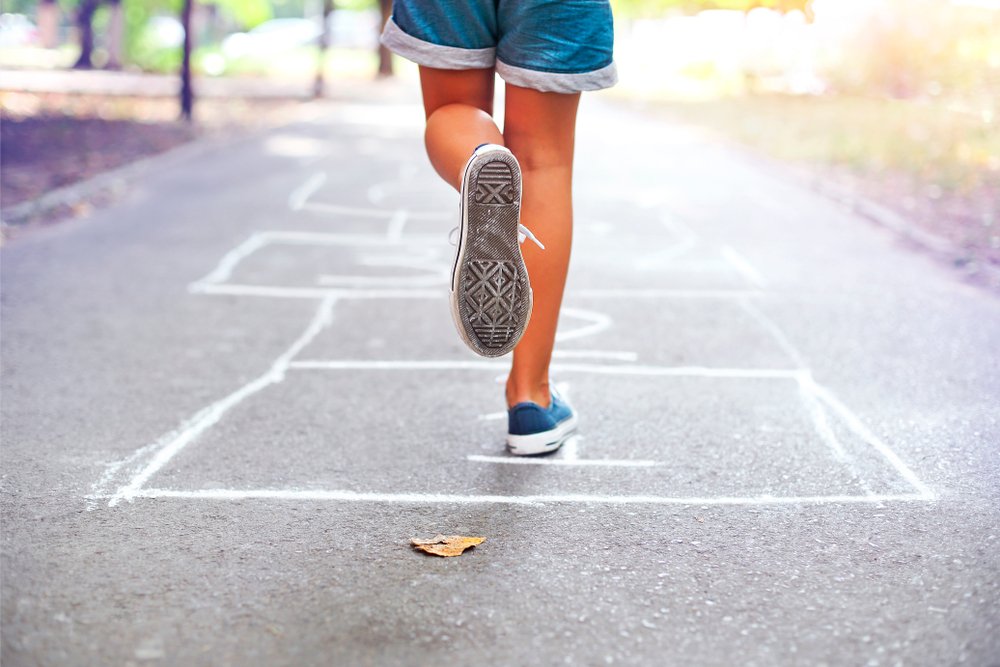Last Updated on January 25, 2024 by Gamesver Team and JC Franco

In the recent age of technology, children need a little bit of inspiration to play outside. Hopscotch is a great way to have fun outdoors and create a new experience for your children. This game is played mainly by kids, but still, it can be enjoyed by people in all age groups.
As a player, you need to throw the object into the patterns on the square, preferably starting with the first square. After this, you need to hop through all the blocks. Do this systematically without touching the object and skipping the square where the object landed. On reaching the end of the board, you hop back and stop to pick up the object.
You lose this game if you step on the line or outside the board. You win when you manage to hop to and from all blocks in the board, collecting the marker without falling off or stepping on the lines.
One primary thing to note is that hopscotch can be played with one or more players. Also, to play this game, you need to have a small object – which can be a small rock, a coin, or any other object you prefer, and a hopscotch board.
Hopscotch is a traditional game that has stood the test of time. Although it has evolved, it is still a fun game to play.
Let’s explore 12 valuable lessons kids can learn from playing hopscotch.
1. Consideration
For the success of the hopscotch game, players need to practice consideration for one another. One player plays at a time. Children learn how to compromise and trust that they will get their turn to play.
The other player plays only after the first player fails or succeeds. Children learn how to cooperate effectively without compromising one another. To emphasize cooperation, players can play the game together.
Consideration enables children to develop and form healthy relationships throughout their lives. They learn the importance of sharing, helping one another, courtesy, and the art of thinking about one another.
2. Coordination
Coordination is another critical skill children learn from the hopscotch game. Coordination is important for everyday tasks. Everyday tasks can include sports, eating, taking a shower, dressing up, cooking, schooling, or even working. To achieve this, you need to coordinate your body accordingly.
Hopscotch involves hopping on one leg from one block to another. A child must master how to hop without tripping and know when to stop. They may also learn how to balance their bodies on one leg – a skill that is relevant in life. All of this practice goes towards good coordination development.
3. Counting skills
The Hopscotch game board has numbers ranging from zero to 9. The numbering is dependent on the age group of players. For younger children, you may consider shorter boards. The older players can accommodate more numbers.
Children will therefore gain counting skills as they hop through the boards. Once a player gets to the other end, they are required to come back to the beginning. They gain mastery in counting these numbers in both ascending and descending order.
Kids who have not yet attended school will also gain early mathematical skills. It is a good boost for their school work. Other mathematical skills acquired include measurements, patterns, and shape identification. It’s therefore essential to involve them when drawing the game.
4. Enhances creativity
Playing hopscotch is more fun with creativity. Players can also come up with their own rules while playing the game. Playing skills improve as children grow. Players also get to perfect the game as they grow older due to mastery of the skills attained in playing the game.

Creativity encourages teamwork. Players have to work together while trying to develop ideas to make the game less tedious/boring. They listen to each player’s views and incorporate them to fit the requirements for a successful game. Creativity and teamwork are essential life skills.
5. Enhances strength and balance
The game involves hopping from one point to another. At the same time, balance is critical to avoid tripping over or losing balance. As a result, motor skills are developed. The changing of positions and moving around builds a child’s physical strength and balance.
Balance is an important part of the development process for children. Children need good balance and strong muscles for walking, running, and playing with other children. Participating in any other physical activity becomes a hassle-free task for these children. In the same way, they can approach life with strength and balance.
6. Following rules
There are some rules involved when playing hopscotch. In order to be successful at the game, children have to strategize to get from one side to the other without breaking the rules. This helps to develop cognitive thinking.
A player will learn when to land on two feet, how and where to throw the object, and how to jump. They will also learn which foot to use, how to turn around, and how to pick up the object. As you can see, this game involves a lot of brainwork.
Children learn that in life, rules exist. It shows them the importance of following them. At the same time, they can follow the rules and have fun. Following rules correctly allows them to live a free and fun life – this is a great life lesson for growing children.
7. Responsibility
Children need to learn a sense of responsibility from an early age. When playing hopscotch, children learn to become responsible for their own actions. Only they can affect the outcome of the game.
While playing hopscotch, stepping on the lines means you give way for the next player. Successfully finishing the game means you start the game over again. In both cases, whether you win or fail, there is an outcome for your actions, and only you are responsible for it.
A sense of responsibility is a life skill that everyone should adopt. It should be taught early in life to nurture a more responsible generation. Hopscotch is a fun way to help foster a sense of responsibility in children at a very young age.
8. Motivation
Motivation plays a critical role in living a positive and healthy life. It helps develop self-awareness and spurs people on to reach new achievements. It’s a guiding force in life. Children need to have the motivation to play, get an education or participate in daily activities.
Hopscotch offers motivation but in a fun way. Playing the board to completion gives the player a sense of achievement. As a result, they feel motivated to come back to play again. A player always stays focused on the game with the hope of winning against the other.
9. Care and Self-love
In today’s world, technology has dominated people’s daily routines. Social media and peer pressure are the order of the day. People are easily overworked and overburdened by societal expectations. They have little time to take care of themselves, let alone love themselves more. As a result, this creates a generation of people who tend to overreact when overwhelmed.
Hopscotch game allows players to break away from the usual routine. It’s playtime that translates to self-care and more self-love. It’s also relaxing for the mind. Children who play the game at an early age can recognize the importance of playtime in life.
10. Resilience
Although hopscotch is a simple game, it requires resilience to succeed. Balancing your whole body on one leg requires mastery.
A player needs resilience to hop from the start to the end, come back to the beginning, and stop on the way back to pick the object without tripping or even falling.
Resilience is an essential skill that should be taught to children early in life. You will be faced with challenges. When children learn this early in life, they are best prepared for when quick thinking and determination are required.

11. Awareness
Children will be required to use a hopscotch board in a specific area and use particular rules. They should also be aware of the difficulties that they face in the process. Although they are free to act and think independently, they have to remain within the blocks.
They learn the importance of making adjustments in their lives to fit into the world. Adjusting to stay and fit in the boxes requires them to move carefully. It cultivates a culture of understanding and appreciates the necessary boundaries in life.
12. Strategy and planning
Hopscotch has a starting point and a sequence that is followed every time a player takes their turn. Players must focus on where they throw the object and remember the spot as they move on to the next block.
Players learn the importance of prioritizing, strategizing, and having plans in life. They also learn strategies and stick to the project to have a smooth life.
Last word
Hopscotch is a traditional but straightforward game that has instilled essential life skills in children over the years. It’s a game that enables children to master skills positively and quickly. It prepares children to handle positive or negative outcomes in the right way. Character developed in the process makes the world a better place for them.

